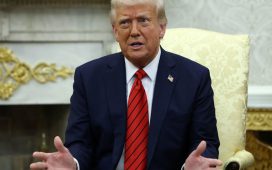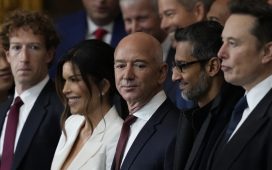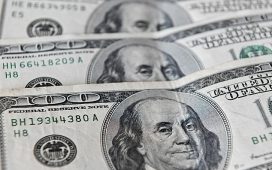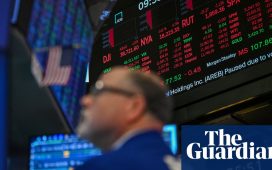This article is an on-site version of our Unhedged newsletter. Sign up here to get the newsletter sent straight to your inbox every weekday
Good morning. The retail price of beef in the US has hit a record, driven by droughts across American cattle country. We have tried to stay calm about inflation over the past few years, but if steak becomes unaffordable, the Unhedged team is going to succumb to economic panic (more rational thoughts on the link between inflation and sentiment can be found below). Email us: robert.armstrong@ft.com and ethan.wu@ft.com.
Bad consumer sentiment is not surprising
A common complaint among Democratic partisans is that Joe Biden and his party do not get credit for a strong economy, which features employment and real growth levels ahead of those seen in the rest of the developed world. And sentiment is not getting any better even as the inflation rate grinds down and markets stage a recovery. The preliminary November reading for the University of Michigan consumer sentiment survey was 60.4, the lowest since May and consistent with the miserable sideways trend that extends back almost two years:

At Unhedged, we don’t find this surprising at all. Prices are up almost 20 per cent since the pandemic began; the price of food is up 24 per cent, energy 37 per cent. That this should make the world feel malign and unpredictable is only natural. It doesn’t matter that wages have, on average, kept pace. If I get a raise, I earned it; it is not a mere symptom of a strong national output. If the price of food is spiralling upwards, that’s a bad economy, or the government’s fault. Nor does it matter that the rate of inflation has fallen. People don’t see the rate of change on the side of a gallon of milk. They see a price that is vastly different from what it once was.
Even so, one might ask why sentiment has not improved even as arguably the most important price of all — petrol — has come down in the past six weeks. That can be explained by the fact that while consumer sentiment can fall quickly, it is slow to recover. It is like a personal reputation: built slowly, gone in an instant. Notice how sentiment (the blue line in the chart below) fell very quickly in the recessions of 1991, 2001 and 2008, but then took its time coming back to a consistently high level.
The current moment can seem a bit odd inasmuch as consumer sentiment and changes in real spending (the pink line) seem to track one another historically but are now coming apart. How can people feel that times are bad, and yet keep spending merrily? Well, if you accept that people believe that changes in nominal prices are something bad in and of themselves, whatever nominal incomes are doing, that mystery goes away. Sentiment and spending do not have to travel together.
Yield curve control: a lesson (or warning) from Japan
Last week in Unhedged, Jenn Hughes asked if yield curve control might reach the US. This would be an extreme outcome, but it takes only a little imagination to see how we’d get there. A historically large peacetime fiscal deficit is suddenly paired with significantly positive real interest rates; politicians remain hostile to tax increases or spending cuts; bond investors grow nervous, and an external shock sends yields soaring. The central bank concludes that monetising the debt is the least-worst option.
Does that make you feel anxious? Fiscal doves have a calming response: Japan. There, public-sector debt runs above three times GDP, and the Bank of Japan has bought most of the government bonds for a decade without causing a disaster. And now Japan’s economy is finally experiencing inflation and nominal wage growth, while corporations are slowly reforming themselves. Real GDP is on track for 2 per cent growth this year, projects Marcel Thieliant of Capital Economics. Extraordinary fiscal and monetary interventions appear to have bought Japan the time it needed.
But a new paper by YiLi Chien of the St Louis Fed, Harold Cole of the University of Pennsylvania and Hanno Lustig of Stanford, suggests that Japan’s example is not as encouraging as it appears. Chien, Cole and Lustig argue that Japan has staved off a fiscal crisis by, in effect, running a massive carry trade to finance itself over the past three decades.
In a standard yen carry trade, investors take advantage of low Japanese rates by borrowing yen, exchanging them for dollars, and investing the dollars at higher US rates. This is risky, because either currency can move against you. But it can be lucrative.
The Japanese authorities have done something similar by financing risky investments with artificially cheap financing provided by Japan’s households, using the banking sector as a middleman. The authors (hereafter abbreviated CCL) see two problems. Japan’s fiscal and monetary set-up acts as a giant transfer from the young, poor and financially unsophisticated to elderly pensioners, the financially savvy and the state; and the trade might ultimately fail.
CCL present a composite balance sheet for the Japanese public sector, including the central government, the BoJ and the state pension fund. It has changed a lot since the 1990s (all figures are a share of GDP):

Note, on the liabilities side, the roughly 100 percentage point increase in bank reserves and, on the assets side, the rise in equities and foreign securities.
CCL offer the following theory of the case:
-
The Japanese public sector borrows at shorter durations, via bonds and bills (average duration of seven years). Most importantly, the central bank issues bank reserves in return for bonds, keeping interest rates low as part of quantitative easing. This is debt monetisation.
-
Through the state pension fund, the public sector invests in longer-duration risky assets such as equities and foreign securities (average duration of 23 years). These positions are not hedged for interest rate or FX risk, letting the state “harvest carry trade risk premia”.
-
The BoJ’s QE pins government bond yields, keeping government borrowing costs low. This lets the government issue overpriced bonds to raise fresh debt, because private investors know they can simply turn around and sell them to the BoJ.
-
The public sector is levered long duration; it gains when rates go down. This trade pays a lot: as much as 3 per cent of GDP a year. This roughly matches the gap between taxes and government spending promises (excluding interest payments), around 3.5 per cent of GDP.
It is a carry trade where the investor sets their own funding costs. The additional fiscal capacity created by cheap funding — and the fiscal penalty if funding costs rise — gives the public sector a strong incentive to peg real rates low.
But while the public sector gains, many Japanese lose. Most households, especially younger ones, barely own financial assets. Wealth is disproportionately kept in bank deposits, to the tune of 200 per cent of GDP, which have no duration and pay essentially nothing. Some Japanese do invest in stocks (38 per cent of GDP) or have a private pension or insurance plan (98 per cent of GDP). But overall, surpluses are being moved from deposit-holding Japanese to the state and pensioners.
Is this set-up stable in the long run? We put that question to Stanford’s Lustig, who argues it is not. He draws an analogy to underfunded US pension schemes which, to improve funding ratios, take more risks on the asset side of the balance sheet in the hope of better returns. The danger is that mandatory liabilities are being matched with assets that can lose value. “The Japanese government has made all these risk-free promises to pensioners and issued bonds that are supposed to be risk-free. But on the asset side they’re increasing equity exposure quite dramatically,” he says. “This doesn’t end well unless you’re extremely lucky. You could get a bad draw of equity returns, and end up with an even bigger shortfall.”
Asked what lessons he draws from Japan for a US context, Lustig added: “Central banks can flatter your estimates of fiscal capacity quite a bit. But when they step back, you realise it’s much smaller than you thought it was.” (Ethan Wu)
One good read
“Far from being an equity game, private equity is a debt game in which the economics are driven by the cost of money.”
FT Unhedged podcast

Can’t get enough of Unhedged? Listen to our new podcast, hosted by Ethan Wu and Katie Martin, for a 15-minute dive into the latest markets news and financial headlines, twice a week. Catch up on past editions of the newsletter here.








